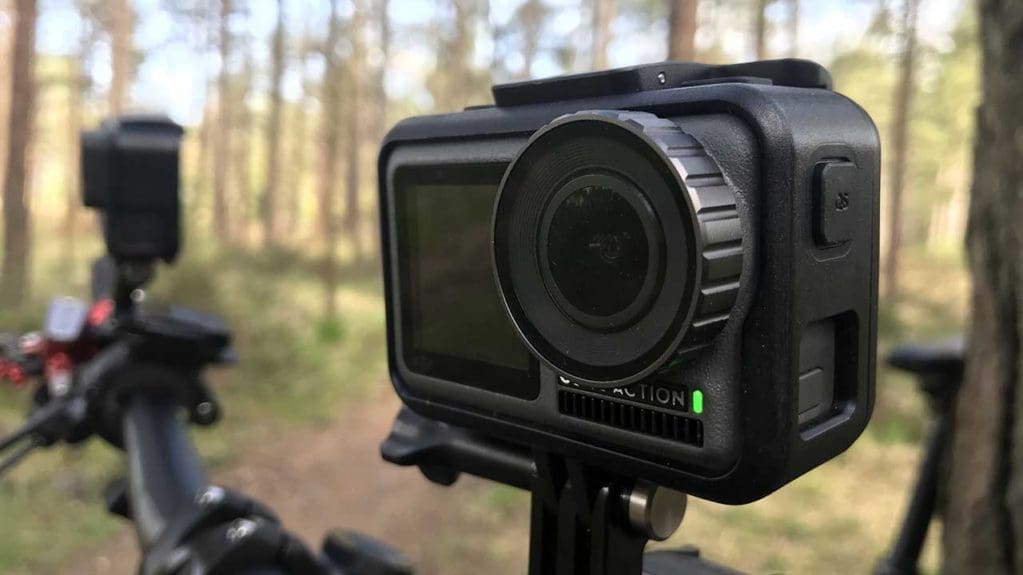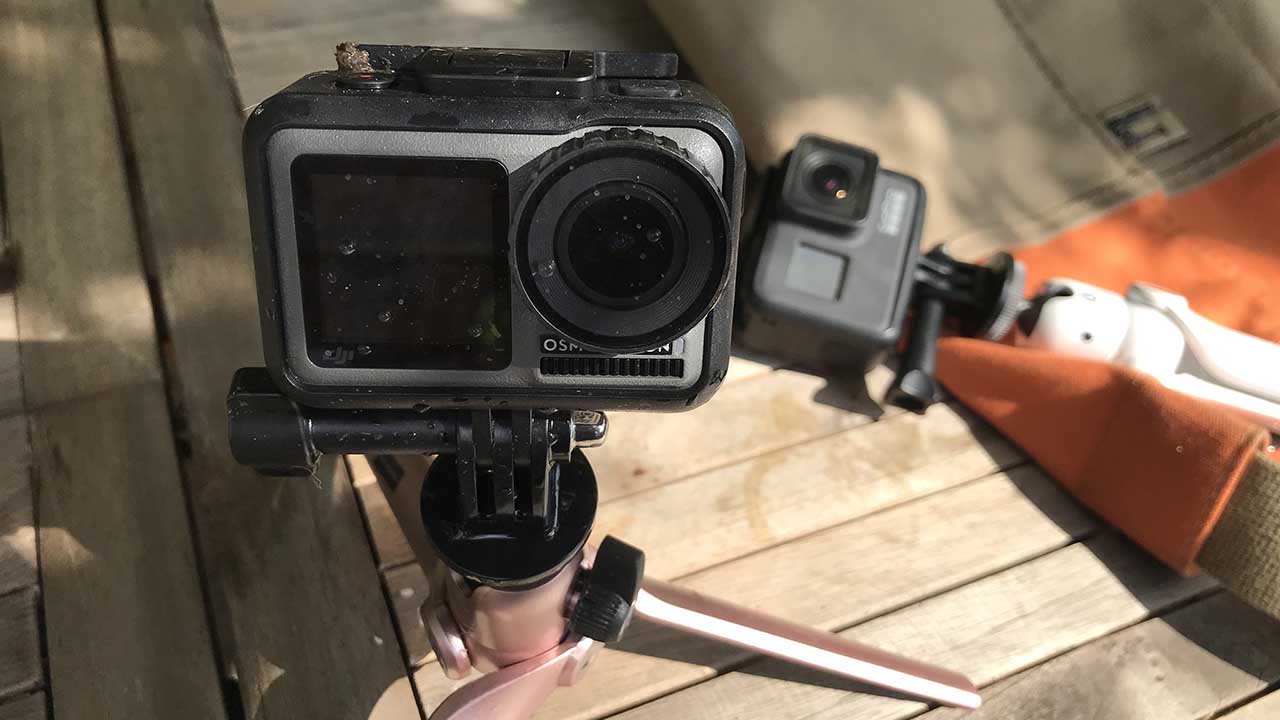A long time ago a small drone manufacturer from China realised that their customers were sticking GoPro’s to the base of their drones. Not long after they released the first generation of the iconic Phantom designed with an integrated GoPro plate.
You can purchase the accessories and DJI Osmo Action at the DJI Store or from retailers like Adorama, B&H Photo Video, Wex Photo Video and Park Cameras.
As time went on that company started to design their own cameras that were more suited to aerial photography and this expertise and development has resulted in the DJI Mavic 2 Pro.
In the beginning, there was GoPro and DJI as a perfect combo, but then DJI developed and expanded its own imaging range.
A couple of years ago GoPro launched their Karma Drone and while the concept and ecosystem of GoPro, Drone and Grip was a good one an early issue with the drone essentially killed the project before it had time to truly take off.
Early issues with the hardware were a major factor but the release of the first generation DJI Mavic was essentially the killer blow.
After the crash of the Karma Drone GoPro had to take stock and refocus back on to its core. The new GoPro design was good but lacking in killer upgraded features.
The GoPro Hero 6 Black followed and although good with updated 4K at 60fps and featuring an all-new processor, the GP1, it really wasn’t as exciting as it should have been.
And then it happened, the GoPro Hero 7 Black, when it was announced it was seen as a bit of a wet kipper. No real updates to resolutions and framerates and no big features, just electronic image stabilisation technology called HyperSmooth.

This is when everything changed, HyperSmooth which initially seemed like a so what feature brought stabilisation to the GoPro of a type that had only previously been possible with mechanical stabiliser gimbals.
Ok, it made the Karma Grip redundant but the quality of the video was unrivalled, the GoPro was once again so far ahead of the competition that there was nothing close to the usability, ruggedness and quality of the new GoPro.
So it has been until now.
The Osmo Action from the outset looks set for action. It’s gunmetal grey exterior, tough rugged design and the large durable touch screen is just the start of the advanced technology the hard exterior has been designed to protect.
This is the first action camera to truly match GoPro’s pedigree and quality.
This is a battle that doesn’t just follow the headline resolutions and framerates but goes far deeper into the features and ecosystems that both offer.
While GoPro has dominated the world of action cameras DJI has taken the skies.
There’s much cross over between the two and the inevitable question is who will win the battle of the action cameras, ultimately which is best the GoPro Hero 7 Black or DJI Osmo Action.
What should you be looking for in an action camera
Action cameras are designed to be taken anywhere and enable you to capture footage that would otherwise be impossible.
In order to do this, they need to be tough and stand up to a knock or two, a quick drop and a bit of a dunk in water along with a complete hammering in general use.
An action camera should be waterproof, not water resistant. It should be able to withstand being fully submerged underwater to a depth of at least 10m without issue.
It should also be able to be dropped, bashed, smashed and come out the other end in one piece and with the footage captured altogether.
Putting this in context the GoPro Hero 7 Black and Osmo are pretty evenly matched.
Osmo Action Vs Hero 7 Black which can go deeper?
Both cameras are protected by a cage rather than all-encompassing housing. This helps with the usability of the cameras in and out of the water.
Osmo Action is waterproof up to 11m Vs the Hero 7 Black at 10m.
Osmo Action Wins
Osmo Action 1 / Hero 7 Black 0
Resolutions and framerates
For years we’ve been obsessed with action cameras resolutions and framerates and with good reason. Higher resolution means more detail and a bigger image, unfortunately, it also usually means a slower framerate.
Filming action you need a fast framerate, really 60fps or more, while this is common at 1080p it’s still unusually at 4K.

Both cameras perform amicably at this top resolution and side-by-side it’s hard to separate which is the best.
While the resolution is the same the visual quality of the footage is different from the Osmo Action displaying far more natural tone and colour.
The amount of shadow and highlight detail captured by both is very similar but the Osmo is slightly prone to overexposure. Dial in a little exposure compensation and the two cameras are more evenly matched for quality but the GoPro just manages exposure a little better.
GoPro Hero 7 Black Wins
Osmo Action 1 / Hero 7 Black 1
But then there’s more to it. You also want a bit of slow motion, you get a certain degree with 60fps which will stretch one second of captured footage to two seconds, but then you want more.
Lowering the resolution to 1080p will enable you to boost the framerates further with both the Hero 7 Black and Osmo Action offering up to 240fps. This means that for every second of footage you capture you can get up to eight seconds of playback.
Both cameras also offer 720p, but this is really just a space-saving exercise when it comes to storage.
Looking at footage shot at 1080p 240 fps and the results from both cameras is again impressive but the Osmo Action just takes it for the level of detail.
Osmo Action Win
Osmo Action 2 / Hero 7 Black 1
HyperSmooth Vs RockSteady
HyperSmooth was the feature that projected GoPro firmly back into first place, although to be honest it never really slipped to second. Now DJI has entered with RockSteady a similarly powerful image stabilisation feature.
In the past electronic image, stabilisation has been a little ropey, to say the least, it worked to a degree but wasn’t exactly spectacular. The introduction of mechanical gimbal stabilisers enabled action camera users to capture the smooth footage they always wanyted and due to the compact size, it was all very convenient.
then Hypersmooth happened to offer the same quality of stabilisation that was offered by mechanic stabasliers electronically. This meant the small compact form of the action camera remained small and compact and revolutionised the genre.
Side by side the two are equally good, one doesn’t really seem any better than the other.
Draw
Osmo 2 / Hero 7 Black 1
DJI Mimo Vs GoPro App
What do you need from an App?
The bare basics are to connect and control, but today we expect so much more from our apps.
GoPro has split their app into several with the main GoPro App enabling you to control the camera remotely, adjust settings and enter modes with a few quick taps of the interface.
The GoPro App has been through many incarnations and with each release, small tweaks have been made that add to the overall user experience.
Most recently you have GoPro’s own online storage facility and of course, there’s the huge GoPro community which you can check out with footage and videos from their huge fan base.
The App in its present form has been around for a few years and GoPro have been experts at listening to their vocal user base. This means that with the addition of GoPro’s other Apps and Desktop software you have a powerful set of tools that will see you through from filming, editing to sitting on the sofa/couch eating pizza.
Now let’s turn our attention to DJI’s offering, the Mimo App.
Again DJI has a history with the quality of their App’s have been utilising the power of mobile technology in their drones and other image stabilisers.
The Mimo App is a little simpler to use than those used for the drones, which is no surprise, as there’s far less information to handle.
again there’s plenty of features to enable you to take control of the action camera and once you’ve captured the footage you want you can then download, edit, overlay music and share with your friends as and when you see fit.
Both Apps from DJI and GoPro have added features including LiveStreaming and enable you to quickly and easily update the firmware when it becomes available.
At present, the DJI App is updating on an almost hourly basis with features being added and improved. I’ll bring you more on the functionality as it updates.
New features rolling out for the Osmo Action
When the DJI Osmo Action arrived a couple of weeks ago it showed potential and with every new firmware update that full potential is realised.
It has now be announced that the Osmo Action will feature Audio in for an external Mic attachment and will have the ability to livestream, although the details of these have yet to be fully disclosed. Having a look around the interface and plugging in a variety of adapters doesn’t see to make much difference at this point.
DJI Osmo Action Vs GoPro Hero 7 Black where we are now
At present with the GoPro Hero 7 Black with a retail price of £379 and the Osmo Action at £329 that £50 difference really does differentiate the two cameras.
If you’re looking for pure image quality then both cameras are evenly matched – there really is very little in it.
Looking at the cameras further and you start to see where the years of development just push GoPro into the lead.
GoPro has finally got to a place where it has all the features you think it should have, top of the list is, of course, the video resolution of 4K with a framerate of 60fps, but then it adds so much more.
Beyond the incredible image stabilisation and visual quality offered by both cameras, there are all those extras. The DJI Osmo with the firmware updates and release of accessories is quickly catching up, especially with the audio in and live streaming.
But, there are other smaller features that are essential such as the ability to choose your field-of-view. DeWarp is a start but there are just two options and that feels like a bit of an issue.
Then there’s the fact that there appear to be no motion sensors or GPS, this seems a little strange for a company that specialises in Drones and has the technology pinned down.
A £50 price difference might not seem like a lot but it’s a relatively large percentage of the full price. For the additional £50 you do get a product that has been refined through years of development, however, the Osmo Action supplies you with the tools you need to just get out there and have fun. Do you really need GPS and Motion sensors?
At present there is one final consideration, the Osmo Action has just launched and it will cost you £329, whereas the Hero 7 Black has been around for a while and can be found on the high street for an average of £319.
In the coming months expect to see the Osmo Action drop in price, if DJI can afford to keep the £50 price difference in the RRP between them and GoPro then we could have a very interesting battle ahead and one that could see the end for GoPro.



